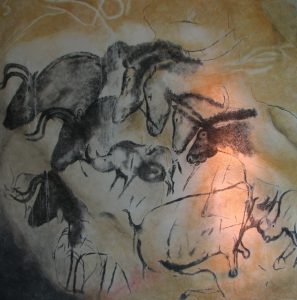Approximately 150 meters above the meandering Ardeche river in France sits an uncharacteristically large limestone cave. Inside, two torches are illuminating a space seventy-five feet from the cave entrance. On the soft clay-like floor, a young woman is pensively cooking meat over a fire, seasoning it with native herbs from the grasslands nearby.

Finely made tools, neatly arranged, rest near a couple of wooden carved animal figurines – their tiny shadows dancing with the flickering light. As the woman turns the meat, she’s humming and adoringly watching the two men in her life scrape the adjacent cave wall clear of debris and concretions. The wall is becoming noticeably lighter and smoother.
The task almost complete, the little one – a boy no older than 4 – hands his father a short stick whose end has been roughly carved into a point. On the earthen floor sits a number of bowls containing pigments derived from ochre, hematite, manganese oxide and charcoal.
The father takes the stick – a smile and glance to the mother of his child as well – and dips its end into the ochre-like substance. He begins to smear an outline of a wild horse on a slight wall protuberance, his son watching every move. The mother comes over, puts her arm around the boy’s shoulder and kisses his head. She says something to the father who nods in agreement.
The beauty of God’s natural creation is being illustrated by skilled hands on a wall in a cave – an artist at work – and reverently observed by a family united in love.
The nearest torch also lights up the adjoining wall which angles in at thirty degrees and connects to their current “canvas.” It is this area where one sees paintings of hyenas, mammoths, panthers and bison – even hand prints. It’s a veritable “museum exhibit” of prehistoric art.
If one were to go outside the cave and stare at the horizon, nature in its pristine glory would be all that one would see. If a Gregorian calendar existed, it would be December 25, or thereabouts. But it’s the upper Paleolithic era – thirty thousand years ago. Before agriculture. When man began to demonstrate an ability to use complex symbolic thought and express cultural creativity – such as on a cave wall. When language originated and young families learned to communicate.
Moreover, it was before the Old Testament. And before Christ, the Word made flesh and new covenant, would walk the land as God incarnate.
On this specific day, where was God?
Or better said, in this prehistoric time before history, in the primitive days of human existence, where was God?
The Catholic Church provides some insight.
- The desire for God is written in the human heart, because man is created by God and for God; and God never ceases to draw man to himself. Only in God will he find the truth and happiness he never stops searching for:
- This invitation to converse with God is addressed to man as soon as he comes into being.
- By natural reason man can know God with certainty, on the basis of his works.
And where is He now, these difficult times? He’s where He’s always been!
Beloved, let us love one another, for love is from God; and everyone who loves is born of God and knows God. (1 John 4:7)
Whoever does not love does not know God, because God is love. (1 John 4:8)
When you’re with family on Christmas day, you experience love. Thus, you experience God. You see, your soul is embraced by Him. At some mysterious level, you know it as a manifestation of Truth.
When our prehistoric cave ancestors experienced love – the artist father, the nurturing mother, the obedient son – they experienced God. Their souls were clutched by Him. At some inexplicable level, they knew it as an embodiment of Truth.
Wherever love is, so is God. Forever and always.
Merry Christmas and God Bless everyone!
